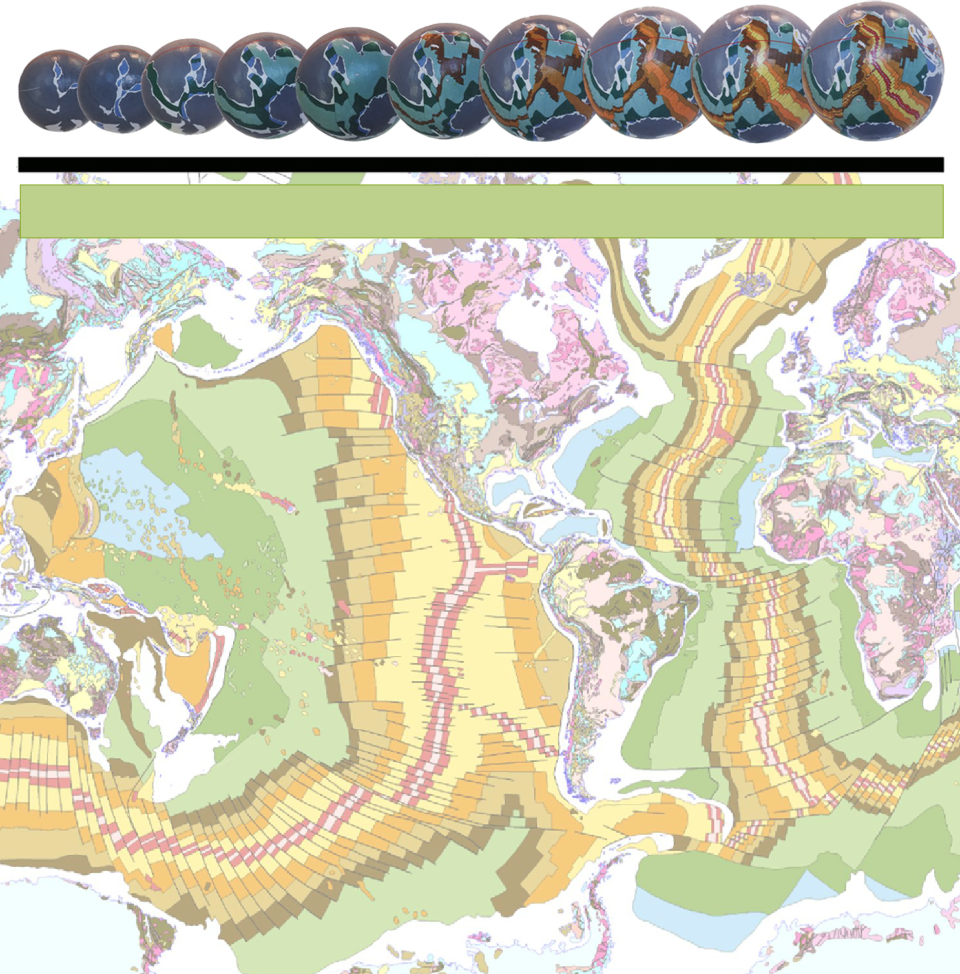ANTARCTICA
The continental development of both East and West Antarctica is speculative because of the masking effect of the present-day ice-sheet coverage. This ice cover, as well as the ice-sheet covering Greenland, is part of the Geological Bedrock Map of the World map used to construct the small Earth models and could not be removed during model construction. The Antarctic icecap is known to be about 33 million years old. Reconstructions indicate that the East Antarctica continent comprises mainly Precambrian crusts and this crust has remained relatively intact throughout Earth history.

The continental crustal development of East and West Antarctica on an Expansion Tectonic Earth (shown as pale blue—the present-day south-polar ice shelf). During the Archaean to late-Palaeozoic Eras Antarctica straddled the ancient equator. The continent then rapidly migrated south, as the modern oceans opened, to its present location at the South Pole. The horizontal red line represents the location of the ancient equator and blue lines represent the ancient coastlines. Note: models 13 to 24 are centred on the South Pole (shown as blue dots).
The Expansion Tectonic continental reconstruction of Antarctica shows that, unlike present-day East Antarctica, during the Precambrian Eras West Antarctica was made up of small remnants of Proterozoic crusts. The reconstructions also show that during Precambrian and early-Palaeozoic times the primitive crusts making up both East and West Antarctica straddled the ancient equator. These continental crusts were located adjacent to primitive Australia, South America, South Africa, India, and Central and Southeast Asian crusts.
Break-up of the former Pangaea supercontinent to form the modern Antarctican continent commenced during early-Permian times during a period of crustal rupture and opening of the South Pacific Ocean—the ancient South Panthalassa Sea. By the Late Jurassic, opening of the Indian and South Atlantic Oceans had also commenced leaving a land connection between Australia and East Antarctica and similarly between South America and West Antarctica. Final breakup, rifting, and separation of modern Antarctica from Australia and East Antarctica commenced during the Paleocene, some 66 million years ago.
On an Expansion Tectonic Earth, the development of West Antarctica relative to East Antarctica is closely related to opening of the South Pacific Ocean. By the Late Cretaceous West Antarctica had separated from East Antarctica and had begun to rotate clockwise, relative to East Antarctica, as the South Pacific Ocean continued to widen and open. During that time the West Antarctican Peninsular remained joined to the southern South American Peninsular. This peninsular continued to remain joined until separation and rifting between the two continents began during the Miocene leaving modern East and West Antarctica as separate and isolated continents through to the present-day.
Throughout Precambrian and Palaeozoic times the Antarctican continent straddled the ancient equator. Once breakup was initiated the combined East and West Antarctican continent is then shown to have commenced an apparent migration south, relative to the ancient South Pole. It then continued migrating further south to its present south-polar location throughout Mesozoic and Cenozoic times, establishing and preserving the present south-polar ice-sheet.
This reconstruction and migration history shows that Antarctica evolved throughout most of its history within a warm tropical environment prior to migrating south into high southern and then into south polar-regions. A close look at the various small Earth models also shows that Antarctica is currently not stationary over the South Pole, as convention suggests, but is continuing to migrate slowly across the south-polar region. It is also important to note that seafloor mapping shows that the surrounding Southern Ocean contains a single, continuous mid-ocean-rift zone. All of the surrounding continents are, in fact, migrating north away from Antarctica as new seafloor crust continues to be extruded along this mid-ocean-rift zone.
This is a fatal flaw in plate tectonic reconstructions, whereby a suitable explanation cannot be given to explain why there are no subduction zones available to absorb this huge amount of Southern Ocean seafloor crustal spreading.


